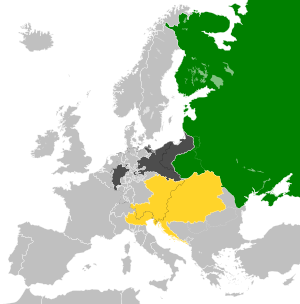Holy Alliance facts for kids

The Holy Alliance was an agreement between three powerful countries in Europe: Austria, Prussia, and Russia. It was formed after Napoleon was finally defeated. The alliance was signed in Paris on September 26, 1815.
The main idea behind the Holy Alliance was to keep kings and queens in power. It also aimed to stop new ideas about freedom and government from spreading across Europe. These new ideas had caused big wars like the French Revolutionary Wars and the Napoleonic Wars. The alliance was quite successful in its goals for a while, lasting until the Crimean War. Later, in 1871, Otto von Bismarck tried to bring the Holy Alliance back together. However, it broke apart again in the 1880s because Austria and Russia had different interests.
Forming the Alliance
The Holy Alliance was largely the idea of Tsar Alexander I of Russia. He wanted European rulers to govern based on Christian values and the idea that kings had a "divine right" to rule. This meant they believed their power came directly from God.
The Tsar wrote the first version of the agreement. It was then edited by Ioannis Kapodistrias and Alexandru Sturdza. The treaty said that European rulers should act like parts of one big Christian family. They promised to help each other.
At first, the agreement was kept secret. Many people who wanted more freedom and change didn't trust it. However, the alliance did manage to limit new ideas in politics until the Revolutions of 1848.
About three months after a big meeting called the Congress of Vienna, the rulers of Catholic Austria, Protestant Prussia, and Orthodox Russia made a promise. They said they would act with "justice, love, and peace" in their own countries and with other nations. They hoped this would make human societies better.
Not everyone joined the Holy Alliance. The United Kingdom, the Papal States (lands ruled by the Pope), and the Ottoman Empire refused. The British Foreign Secretary, Lord Castlereagh, even called it "nonsense." Still, Britain was part of a larger group called the Concert of Europe, which aimed to keep peace in Europe.
How the Alliance Worked
In practice, the Holy Alliance became a strong force against democracy and revolution. Prince Klemens von Metternich, a powerful leader from Austria, played a key role in this. The alliance also helped its members stop Polish efforts to create an independent state. This happened in areas controlled by Austria, Russia, and Prussia.
The rulers in the alliance used it to stop revolutionary ideas from the French Revolution from spreading into their own countries.
The Holy Alliance is often linked to other agreements like the Quadruple Alliance and the Quintuple Alliance. These alliances included the United Kingdom and later France. Their goal was to keep the peace and balance of power in Europe, which had been set up at the Congress of Vienna.
Leaders from the alliance met several times. For example, in 1818, Tsar Alexander, Emperor Francis I of Austria, and King Frederick William III of Prussia met at the Congress of Aix-la-Chapelle. They decided to take strong actions against university students who were pushing for change. This led to the Carlsbad Decrees the next year.
Later, at meetings like the Congress of Troppau (1820) and the Congress of Laibach (1821), Metternich tried to get his allies to stop a revolt in Italy. The Quintuple Alliance met for the last time at the Congress of Verona in 1822. There, they advised against the Greek Revolution and decided that France should invade Spain.
These later meetings showed growing disagreements between Britain and France. They disagreed on issues like Italian unification, the right of people to govern themselves, and problems in the Ottoman Empire.
The Holy Alliance is generally thought to have ended when Tsar Alexander died in 1825. France eventually went its own way after the July Revolution of 1830. This left Austria, Prussia, and Russia as a core group. They came together again to stop the Revolutions of 1848.
The alliance between Austria and Russia finally broke down during the Crimean War. Even though Russia had helped Austria stop the Hungarian Revolution of 1848, Austria did not support Russia in the Crimean War. Austria stayed neutral and even took control of some lands when Russia retreated in 1854. After this, Austria became isolated. This also led to Austria losing its important role among the German states, ending with its defeat in the Austro-Prussian War in 1866.
See also
 In Spanish: Santa Alianza para niños
In Spanish: Santa Alianza para niños
- Biedermeier
- Second League of Armed Neutrality
- Quintuple Alliance
- 1834 Quadruple Alliance
- Unholy alliance (geopolitical)
- Vormärz


